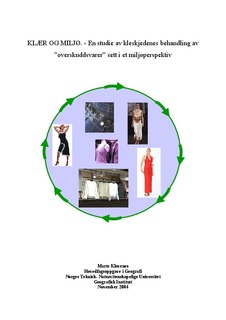| dc.description.abstract | This study focus on nine big clothes chains practise on how to handle their “surplus gods” which is their clothes of complaint by customers, clothes with faults from their producers, wrong purchases, and their samples. It is many ways to take care of these clothes in an environmentally way, still even though they have some minor defects. This study will discover what these nine chains do with these clothes, why, and if they have some activities going on for environmental improvements. In addition to this I like to discuss the nine clothes chains environmentally policy, what it includes, and which aspects of the environment they focus on, and take care of. This angel of incidence because it already exist some studies on consumers and how they act when they get rid of their clothes, but none studies is done as far as I know on how the clothes chains act with their “surplus goods”. The material flow from the clothes chains which ends at the rubbish heap is probably less compared to the flow from consumers, since the use of clothes by Norwegian and other people from the industrialized world is great. The consumption of clothes gets larger, and their lifetime gets shorter. Since clothes are at a lower price level than for 50 Years ago we pay less, but get more clothes, and then throw away even more. Like in 1998 Norwegians threw away a total of 110 000 tons of textiles, and 75 % of this came from private households. This means that each Norwegian threw away an average of 19, 7 kg of textiles this year, and 11, 2 kg of this was clothes. According to Norwegian Statistics, only 7 % of textiles were recycled. In an effort to get a more sustainable society, there has been some focus on the use of resources in production, the distribution of consumer goods, and on recovering and recycling (from the cradle to the grave). Though, because of the environmental aspects, one effort is to use the clothes twice as long, and the environmental costs will be reduced by 50 %. Of course, this calculation presupposes that the clothes are the same, or at least do not pollute more in production/disposal.
These analyse is based on interviews by employees at different levels in these nine clothes chains. All chains are anonymous and are given fictive names. | nb_NO |
